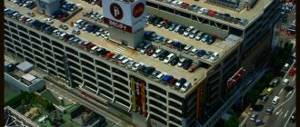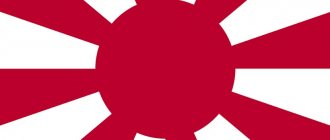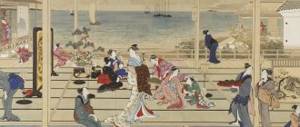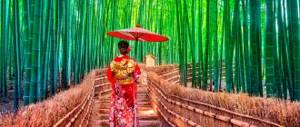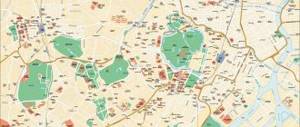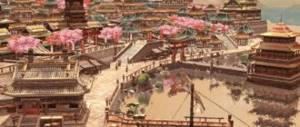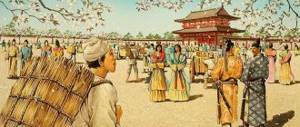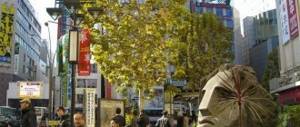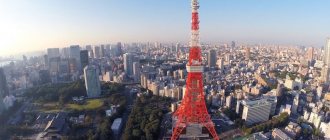The Tokyo Imperial Palace is located in the very center of the capital. This location is not accidental, since initially in 1457, the defensive Edo Castle was built on the site of today's Tokyo, which became the residence of the emperor in 1868. Over time, the castle was overgrown with new buildings. And today the palace of the emperors of Japan is an oasis in the concrete jungle of the Japanese capital.
But the imperial castle was not always located in Tokyo; during the reign of the Tokugawa shogunate, the emperor's court lived in the capital of Japan - Kyoto. And only with the return of state power to the Emperor of Japan in 1868, the court moved to Edo, and the city was immediately renamed To:kyo, which is how the Japanese pronounce the name of their capital, in translation it means “Eastern Capital”.
History of the palace
In the fifteenth century, Edo Castle was a small settlement at the confluence of three rivers, on the shores of a sea bay. Edo translates to "Gateway to the Bay." At the end of the 16th century, Ieyasu Tokugawa established Edo as a political and administrative center, which over time became more important than the imperial capital. At the same time, he began a major reconstruction of the castle. Construction of the castle lasted from 1593 to 1636.
It was a large-scale event in which more than 300,000 people took part. Daimyo (military feudal lords of Japan in the Middle Ages) provided construction materials, mainly delivering granite stones, and those who did not have the financial means took part in the work, dug ditches, strengthened embankments, and made dams. After construction was completed, the castle was a grandiose structure with 38 gates, 20-meter ramparts and 12-meter outer walls. The main tower of the castle was considered the tallest in Japan, its height was 51 meters.
The construction of Edo Castle is one of the greatest feats of engineering in Japanese history.
Even what remains of Edo Castle today testifies to the thoroughness with which it was built.
stone foundation of the main tower
In 1868, the court of Emperor Meiji (reign from 02/03/1867 to 07/30/1912) settled in the shogun castle. In 1873, the castle burned down and on the ruins of the holy of holies of Edo Castle, surrounded by trees and picturesque gardens, already in 1888 a new palace was built for the imperial family, called Meiji Palace.
The castle moats, walls, guard houses, as well as the base of the tower, which is above in the photo, all this remains from Edo Castle.
In May 1945, Meiji Palace burned down as a result of American air raids. It was only in 1959 that a decision was made to build a new imperial palace on the site of the one that burned down. Construction was completed in 1968.
The Imperial Palace is literally home to the Emperor of Japan and his consort. Diplomatic meetings are also held here regularly. On certain days the doors of the palace are open to the public.
The Japanese Emperor is a symbol of the unity of the people
The Japanese emperor, without real power, has long been the national symbol of the country. The prime minister rules the state on behalf of the emperor, but the imperial court still exists in Japan.
The title of emperor of a country is inherited through the male line.
The first Emperor Jimma is considered a descendant of the Sun Goddess Omikami, who created the Japanese state in 660 BC. Since then, the official symbol of the emperor has been the chrysanthemum, the personification of the Sun, which adorns state ceremonies and festive clothes of the imperial family.
The Emperor of Japan is a descendant of the teaching about the harmony of man with nature during his lifetime, therefore he participates in rituals and ceremonies dedicated to fertility and agriculture, and is engaged in charity. During trials and tribulations, only the emperor makes decisions and takes responsibility for what is happening.
The emperor also approves the decisions of the Cabinet of Ministers, having the right to veto any of them. True, during the imperial reign this did not happen. The Japanese dynasty does without ringing titles; the emperor confines himself to only his name and believes that the value of his reign is determined by the correctly chosen motto.
The current Emperor of Japan, Akihoto , rules under the motto "Peace and Tranquility". You can hear and see the monarch only on his birthday, when you come to the palace for congratulations, as well as during the New Year's address to the people or in case of an emergency.
Akihoto became emperor in 1989 after his father's death. The Japanese monarch is under the vigilant protection of a special police detachment. 900 employees - cavalry and honor guard, whose duties include protecting and accompanying the emperor during ceremonies.
Days to visit the Imperial Palace
Twice a year, visitors are allowed into the inner garden of the imperial palace.
The Emperor and his family greet Japanese residents and tourists from a glass balcony and address them with a welcoming speech. This important event takes place on January 2 and the emperor’s birthday.
January 2 is a constant date, on the second day of the new year the traditional meeting of the emperor with the people takes place, and the second date is variable and is the birthday of the ruling emperor. Since 1989, the day to see Emperor Akihito and visit the imperial palace has been December 23rd.
You can read more about the birthday of the Emperor of Japan here.
Hotels near Tokyo Imperial Palace
The Imperial Palace in Tokyo, located in the very center of the capital, is adjacent to the Ginza district. This is the most elite area of the city. This is where expensive shops, restaurants, hotels and administrative buildings are located.
You can stay in the area at one of the following hotels:
- Sotetsu Fresa Inn Ginza Sanchome decorated in a Japanese theme. This 3-star hotel offers air-conditioned rooms, Asian cuisine and in-room amenities. The cost per room for one person in this hotel starts from 7,500 rubles.
- This area is home to the most unusual hotel in the world - The Prime Pod GINZA TOKYO . Price for 1 capsule – 3300 rub. This price includes Wi-Fi, safe, TV, bedding. The hotel has a coffee shop and bar.
- Hotel Gracery Ginza offers rooms from 11,000 rubles. The price includes the room itself with a work desk, breakfast, and Internet connection. The hotel has a massage room.
- Toshi Center Hotel is a 10-minute walk from Tokyo Palace. Here you can stay in a European room or in an apartment with traditional Japanese beds - futons. Room rates start from 3,000 rubles.
- Super Hotel Premier Tokyo Station Yaesu-Chuoguchi is located in Chuo Ward, 4 km away. from the city center. The cost of placement is from 9500 rubles. Finding the hotel is easy - it is located on the corner of Chuo-ku Yaesu 2-2-7, a 5-minute walk from JR Tokyo Station. What distinguishes it from other hotels is 2 hot pools available 24 hours a day.
- Between the Ginza area and the Imperial Palace is a small, little-known area called Marunouchi. Tosei Hotel Cocone Kanda is located here . A room costs from 6,000 rubles.
- A little further from the central attraction is the Akihabaru district. Prices in hotels in this area start from 6,400 rubles. For example, here you can stay at A PA Hotel Asakusabashi-Ekikita, remm Akihabara, HOTEL MYSTAYS Asakusabashi.
When traveling to Japan, you should definitely visit the capital of this country and visit the pearl of Tokyo - the Imperial Palace with its magnificent buildings and well-kept gardens. Getting to know the pearl of Japan will create the foundation for further exploration of this interesting country.
Author: Svetlana Mokeeva
General information
The Imperial Palace is a whole complex of buildings. It is usually divided into western and eastern parts, occupying a total area of 741 hectares. Three shrines were built on the territory of the palace complex - Kashikodokoro, Koreiden and Shinden, the Peach Music Hall, and the Imperial Laboratory. The Nijubashi and Meganebashi bridges and the Fujimi-yagura watchtower are also located.
Many of the complex’s structures are made of concrete; some of the buildings have no historical value, as they were built in the last century after the end of World War II.
The modern imperial palace is very modest compared to Edo Castle, it is characterized by austere simplicity with a touch of sophistication.
Tokyo has passed laws prohibiting the construction of subways under the territory of the complex and helicopter flights over it. The castle is carefully guarded and serves as the official residence of the Emperor of Japan.
The Eastern Palace Park is located at the entrance to the inner palace. Here you can walk for free and admire the beautiful trees; the park has fountains and ponds with fish. The remains of Edo Castle and the Koyo Higashi Gyoen Garden are located here. You can usually admire the emperor's house from afar. You can also visit the Outer Garden of the Imperial Palace and Kitanomaru Park for free.
The castle is surrounded by a thick wall and a moat. Nowadays these elements are preserved as decorative, but in past centuries they performed a protective function.
People are allowed into the garden from 9-00. Closing times vary depending on the time of year. From November to February, visiting ends at 16-00, in the summer months - at 17-00, in September, October and March - at 16-30.
Architecture and interiors
It occupies more than three hectares. The architectural ensemble is a mixture of buildings built in traditional Japanese and European styles. This feature is clearly evident in the main building. Consisting of three floors (one is located underground), it was built from reinforced concrete, but retained the traditional Japanese architecture, which involves the use of wooden structures in interior design.
Inside the former castle there are:
- office;
- dining rooms;
- rooms where honored guests are received;
- banquet hall and other rooms.
Consists of two parts, separated by two bridges. These structures are visible from the central square of the architectural complex. To the side of the main building there are:
- a museum whose collection consists of more than 10 thousand exhibits;
- three palace sanctuaries where the sacred necklace of the imperial court is kept;
- laboratory of the Japanese ruler;
- a concert hall erected in honor of the emperor's wife in the second half of the 20th century.
An architectural park has been created on the territory of the complex, into which old buildings from the 16th to 19th centuries, built in the traditional Japanese style, are brought.
How to get on the excursion
Excursions around the territory located around the palace and in the palace itself are carried out only with the permission of the special department upon prior application. Tours of the palace are conducted in Japanese and English, but as a rule there is nothing to see there, since the atmosphere is quite ascetic and the usual luxury of palaces is absent here.
The palace management forms groups, assigns times and assigns a guide. Opening hours are also determined by this body. The castle gates are closed on Fridays and Mondays. Visits are also suspended on other days when the emperor holds official events.
Vadakura Fountain Park
Very close to the Imperial Gardens is the small Vadakura fountain park. The fountains work alternately and with breaks, so it’s a whole action. Here you need to sit for half an hour, relax quietly in the shade of the trees, and then you will see the whole water performance.
Where is
The palace and its gardens are located in Tokyo's Chiyoda district, in the very center of the city, near Tokyo Station.
They occupy an area of about 741 hectares and are located not far from them: the building of parliament, court, and ministry. All political life is centered around the “imperial” center of Tokyo.
Address: 1-1 Chiyoda, Chiyoda City, Tokyo 100-8111, Japan
Ueno Park
Another large park in Tokyo is Ueno. When I got there for the first time, I was perplexed: the map showed a huge pond, but I saw a field overgrown with burdocks taller than a man. In fact, the “burdocks” turned out to be lotuses growing straight from the water!
There is a temple in the middle of the Shinobazu pond on the island, and further on the shore is the Ueno Zoo. Part of the pond has been cleared of vegetation and there is a pedal boat rental service.
In another part of Ueno Park there are the Tokyo National Museum, the National Science Museum and a number of other museums.
And the same huge carp scurry between the lotus stems.
Of course, there are much more gardens and parks in the Japanese capital. I only talked about three that I managed to visit.
